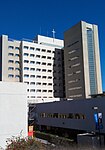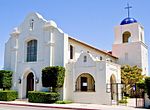UC San Diego Medical Center, Hillcrest

The UC San Diego Medical Center, Hillcrest (also referred to as the Hillcrest Medical Center or simply UC San Diego Medical Center) is one of two medical centers of UC San Diego Health and is a teaching hospital for the University of California San Diego School of Medicine. The 390-bed hospital offers a range of primary care and specialized services and houses several regional services, including the San Diego Regional Burn Center and a Comprehensive Stroke Center. Its emergency department includes the first overall and sole academic Level I Trauma Center serving San Diego County and Imperial County. It and the UC San Diego Jacobs Medical Center are the only two academic teaching hospitals in San Diego.
Excerpt from the Wikipedia article UC San Diego Medical Center, Hillcrest (License: CC BY-SA 3.0, Authors, Images).UC San Diego Medical Center, Hillcrest
West Arbor Drive, San Diego Hillcrest
Geographical coordinates (GPS) Address Phone number Website External links Nearby Places Show on map
Geographical coordinates (GPS)
| Latitude | Longitude |
|---|---|
| N 32.7544 ° | E -117.166 ° |
Address
UC San Diego Medical Center
West Arbor Drive 200
92103 San Diego, Hillcrest
California, United States
Open on Google Maps






